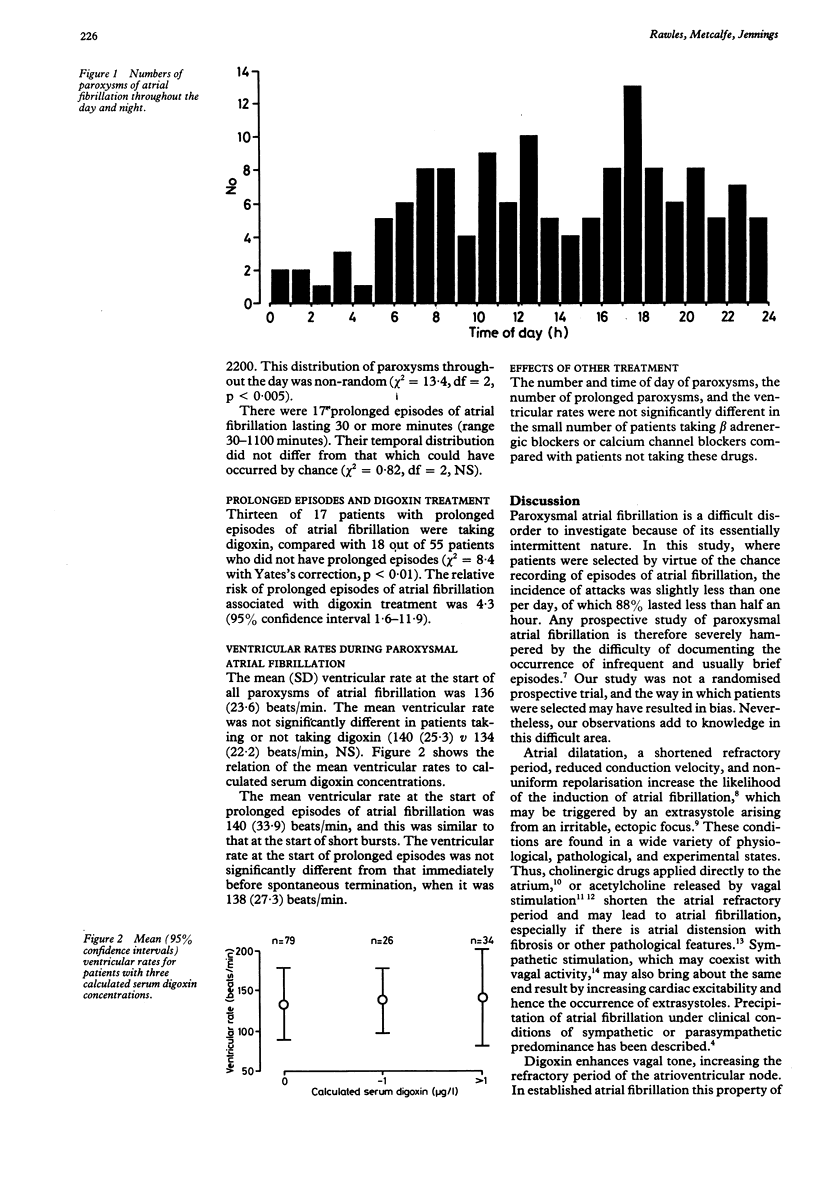Abstract
One hundred and thirty nine episodes of atrial fibrillation were identified from Holter recordings in 72 patients with paroxysmal atrial fibrillation. Paroxysms occurred more often by day than by night, suggesting that attacks are more closely associated with sympathetic than with vagal activity. In 41 patients who were not taking digoxin there were 79 episodes, and in 31 patients who were taking digoxin there were 60 episodes. Significantly more of the episodes that lasted for 30 minutes or more occurred in patients taking digoxin (13/17); the relative risk of a prolonged paroxysm associated with taking digoxin was 4.3 (95% confidence intervals 1.6-11.9). The mean (SD) ventricular rate at the onset of the paroxysms was not significantly different in those taking digoxin (140 (25) beats/min) and in those who were not (134 (22) beats/min). In paroxysmal atrial fibrillation, pretreatment with digoxin does not seem to reduce the frequency of paroxysms, or the ventricular rate when paroxysms occur, but it is associated with longer attacks.
Full text
PDF


Selected References
These references are in PubMed. This may not be the complete list of references from this article.
- ALESSI R., NUSYNOWITZ M., ABILDSKOV J. A., MOE G. K. Nonuniform distribution of vagal effects on the atrial refractory period. Am J Physiol. 1958 Aug;194(2):406–410. doi: 10.1152/ajplegacy.1958.194.2.406. [DOI] [PubMed] [Google Scholar]
- Beasley R., Smith D. A., McHaffie D. J. Exercise heart rates at different serum digoxin concentrations in patients with atrial fibrillation. Br Med J (Clin Res Ed) 1985 Jan 5;290(6461):9–11. doi: 10.1136/bmj.290.6461.9. [DOI] [PMC free article] [PubMed] [Google Scholar]
- Coumel P., Attuel P., Lavallée J., Flammang D., Leclercq J. F., Slama R. Syndrome d'arythmie auriculaire d'origine vagale. Arch Mal Coeur Vaiss. 1978 Jun;71(6):645–656. [PubMed] [Google Scholar]
- Ewing D. J., Neilson J. M., Travis P. New method for assessing cardiac parasympathetic activity using 24 hour electrocardiograms. Br Heart J. 1984 Oct;52(4):396–402. doi: 10.1136/hrt.52.4.396. [DOI] [PMC free article] [PubMed] [Google Scholar]
- Hammill S. C., Wood D. L., Gersh B. J., Osborn M. J., Holmes D. R., Jr Propafenone for paroxysmal atrial fibrillation. Am J Cardiol. 1988 Feb 15;61(6):473–474. doi: 10.1016/0002-9149(88)90312-8. [DOI] [PubMed] [Google Scholar]
- Jelliffe R. W., Brooker G. A nomogram for digoxin therapy. Am J Med. 1974 Jul;57(1):63–68. doi: 10.1016/0002-9343(74)90769-4. [DOI] [PubMed] [Google Scholar]
- KILLIP T., GAULT J. H. MODE OF ONSET OF ATRIAL FIBRILLATION IN MAN. Am Heart J. 1965 Aug;70:172–179. doi: 10.1016/0002-8703(65)90064-5. [DOI] [PubMed] [Google Scholar]


